Sheep and lamb processing: assessment
Research investigating the opportunities and challenges industry faces in retaining and increasing sheep and lamb processing in Scotland.
2 Explaining the decline in Scottish sheep processing
2.1 The current situation
2.1 Highlighting the localities where sheep are most prevalent, Figure 1. shows sheep density (sheep per square kilometre) across Great Britain (GB) in 2017. Whilst areas of the Highlands and Islands have low sheep densities in comparison to better quality grazing land in the lowlands, sheep production is still the dominant land-use in these marginal areas.
Figure 1 GB sheep density 2017
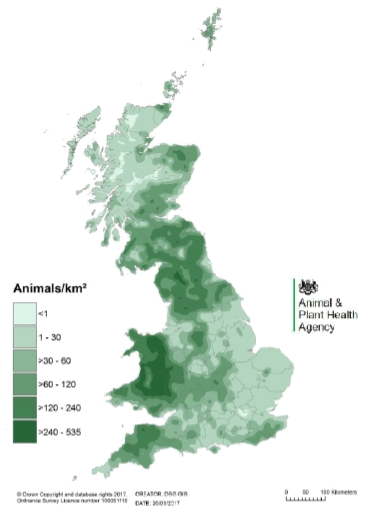
2.2 In 2018 across the UK 12.8 million prime sheep (lambs under one year old) and 1.6 million cull sheep (older ewes and rams) were slaughtered (Defra, 2019). Scottish abattoirs accounted for 1.1 million (8.6%) of UK prime lamb and 22,000 (1.4%) of UK cull sheep (Defra, 2019). An estimated 118,000 English and 16,000 Welsh prime lambs were killed in Scottish abattoirs[3] meaning fewer than 1 million Scottish sheep were slaughtered in Scotland during 2018.
2.3 In 2018 the average carcase weight of lambs processed in Scotland was 20.3kg (QMS, 2018) meaning around 20,775 tonnes carcase weight equivalent[4] (CWE) of lamb were produced in 2018. Scottish cull sheep had an average carcase of 30.8kg (QMS, 2018) in 2018 meaning around 676 tonnes CWE of mutton was processed in Scotland.
2.4 The locations of the main Scottish sheep abattoirs are shown in Figure 2, along with the major processors in England and Wales.
Figure 2 GB sheep abattoirs
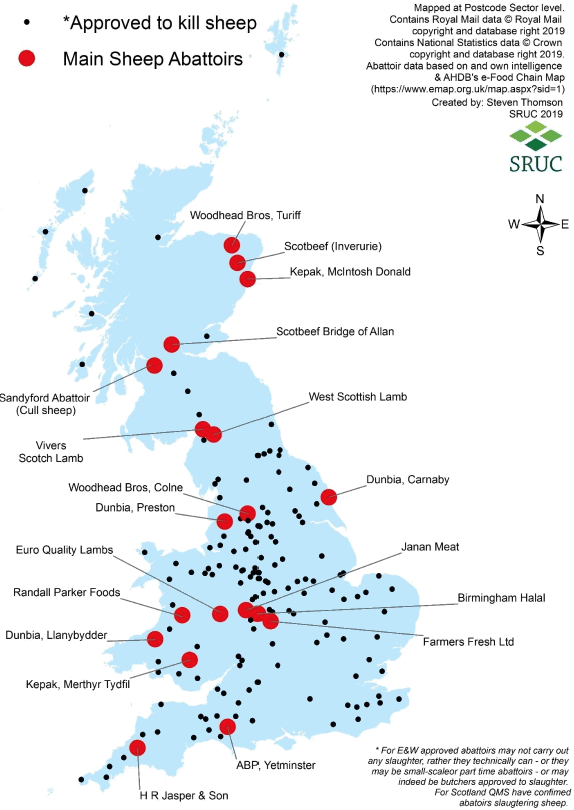
2.5 The Scottish sheep processing sector is dominated by three companies, which accounted for 88% of prime lamb slaughtered in Scotland in 2018[5]. None of these processors slaughter cull sheep but all are dual species (i.e. they also slaughter cattle or pigs) with the exception of a single specialised lamb only abattoir. Based on interview findings the main lamb processors in Scotland are:
a. Scotbeef processes lambs mainly for UK supermarkets while its sister company Vivers[6] (sheep-only abattoir) mainly focuses on premium export markets in the EU. Scotbeef also operates a plant in Inverurie,[7] although few lambs are currently processed there. No cull sheep are slaughtered by Scotbeef at any of its plants.
b. Woodheads is the only supermarket owned processor so kills lambs largely for parent company Morrisons (just under 1,000 lambs a week are killed for a third party). Woodheads plant in Turiff also processes (butchers) most of the prime lamb slaughtered in Morrisons' English abattoir. A small tonnage of lamb cuts are exported to Italy.
c. Irish firm Kepak acquired the former McIntosh Donald plant in 2018 when it bought 2 Sisters red meat division. The number of lambs slaughtered at the Portlethen plant had declined in recent years when the focus had principally been on supplying Tesco's Scottish-based stores as well as supplying around half of Tesco's organic lamb across GB. But the Portlethen plant has increased its lamb kill since the Kepak takeover.
2.6 John Scott Meat (Paisley) Ltd, which operates out of the council owned Sandyford abattoir at Paisley, is the only Scottish abattoir to process a notable number of cull sheep in Scotland. The cull sheep sector is dominated by the plants in the Lancashire, Yorkshire and Midlands triangle that service the GB halal market.
2.7 Lamb processing is also very concentrated at the GB level with three Irish owned processors accounting for the majority of GB lamb slaughtering in 2018:
a) Northern Irish owned Dunbia formed a strategic partnership with Dawn Meats (Irish Republic) in 2017 with the UK operations trading under the Dunbia name. Dunbia process Scottish lambs at their main plants; Preston, Carnaby, and Llanybydder.
b) Anglo-Irish ABP Food Group became a major lamb processor in England when it acquired RWM Food Groups' plant in Yetminster in 2012.
c) When Kepak bought 2 Sisters in 2018, in addition to the Portlethen plant it also acquired St Merryn Meats which had a major lamb (and cattle) processing plant at Merthyr Tydfil and a smaller dual species plant at Bodmin. These three plants will handle around 750,000 lambs[8] annually (though the Merthyr plant can kill up to 24,000 weekly).
Other important abattoirs and processing plants where Scottish lambs may be slaughtered include:
d) Euro Quality Lambs is a specialist sheep processor based in Shropshire. This progressive plant specialises in halal markets in both Britain and the EU and has annual throughput of around 750,000 sheep.
e) West Scottish Lamb Ltd is a relatively small processor based in Carlisle that specialises in light lamb processing and consequently is an important processor of Scottish hill lambs.
2.8 It was estimated that the overall red meat sector (beef, pig and sheep production) contributed around £2.4bn of Gross Value Added (GVA) to the Scottish economy and supported around 33,000 jobs. Of this contribution, £121m of GVA and 2,100 jobs arose directly from processing (Moxey, 2016). It is estimated that that sheep processing accounts for around 15% of Scotland's total red meat processing output (QMS, 2018) which implies that sheep processing contributes around £18m of GVA to the Scottish economy and underpins around 300 jobs directly. As such, a 10% increase in Scottish lamb processing could perhaps contribute an additional £1.8m of GVA and 30 extra jobs.
2.2 Sheep production and processing change since the 1990's
Figure 3 Scottish sheep population 1997-2015
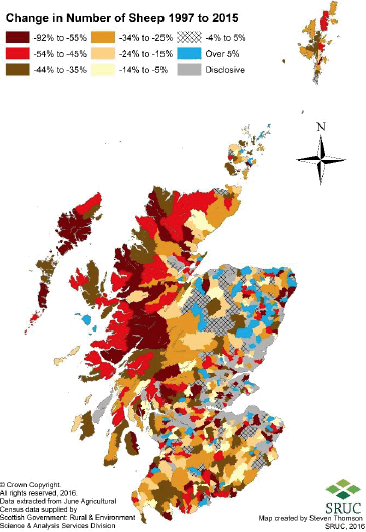
2.9 There has been a well-documented decline in Scottish sheep flock since the mid-1990s (SAC, 2008; RSE, 2008; Thomson, et al., 2011; Thomson et al., 2016) with breeding ewe numbers falling from a peak of 4 million in 1992 to 2.6 million in 2018 – a 36% decline (Scottish Government 2018a, 2018b). The decline in the breeding flock has resulted in 38% fewer prime lambs being reared in Scotland over the last 30 years, with larger declines witnessed in the north-west Highlands and Islands where lighter lambs were more prevalent on marginal grazing land. The changing dynamics of sheep production has inevitably impacted on Scotland's sheep processing sector.
2.10 Figure 4 illustrates the sharp decline in the total number of prime lambs reared in Scotland as a result of the 2001 foot and mouth disease crisis. Ewe numbers and prime lamb production never recovered from that sharp decline (600,000 fewer prime lambs were produced between 2000 and 2002). After a short period of stabilisation prime lamb production declined further as farmers adjusted to decoupled Common Agricultural Policy support payments (from 2005). The main decline in the number of prime lambs slaughtered in Scotland occurred during the 1990s falling from 3 million lambs to 1.8 million between 1991 and 2001. Between 2001 and 2015 the number of lambs slaughtered in Scotland remained relatively stable, fluctuating between 1.3 million and 1.5 million lambs. However, since 2015 numbers have fallen further to just over 1 million lambs in 2018 (a 70% decline since the 1995 peak).
Figure 4 Estimated annual Scottish prime lamb production and location of slaughter
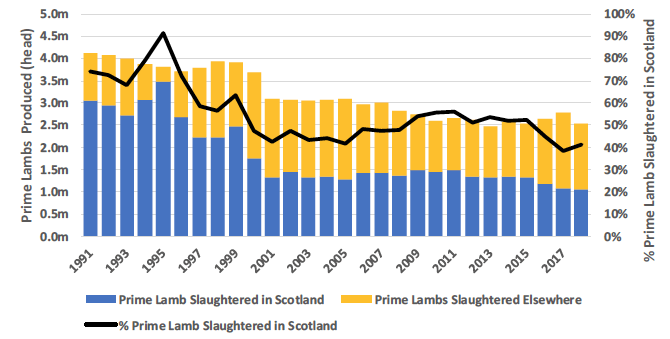
Source: Own calculations[9] based on Defra (2019) and Scottish Government 2018b
2.11 The proportion of Scotland's prime lamb slaughtered in Scotland is affected not only by numbers processed in Scotland, but also changes in overall lamb production. With that in mind, Figure 4 shows that the proportion of prime lamb production slaughtered in Scotland peaked at over 90% in 1995 falling to 41% in 2017 (a data summary can be found in Appendix 2).
2.12 Scotland has accounted for about a fifth of the UK's sheep population over the last 30 years[10], but there has been a long term decline in the proportion of UK sheep slaughtered that occurs in Scotland (see Figure 5). The proportion of UK prime lambs slaughtered in Scotland fell from a peak of 21% in 1995 to only 8.6% in 2018. The proportion of the UK's cull sheep slaughtered in Scotland fell from a peak of 9.3% (220,000) in 1996 to only 1.4% (22,000) in 2018. The importance of freshness and trust in correct use of halal slaughter method resulted in cull sheep processing moving to processors in northern and central England.
Figure 5 Scottish proportion of UK sheep slaughterings
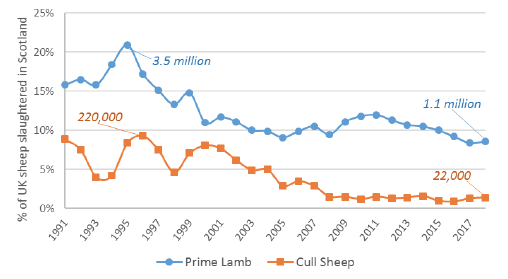
2.13 At the start of the 1990's there were more abattoirs processing sheep in Scotland, and there has been considerable rationalisation of the sector in the ensuing years. Some of the major plant closures have included:
- The gradual closure of Local Authority owned "slaughter houses" significantly reduced the number of abattoirs across Scotland. Often located in the middle of towns close to the market, the undesirable purpose and odours from these plants compounded their demise along with their poor economics.
- In 1998 ANM Group closed their 'Scotch Premier Meat Ltd' Edinburgh abattoir that processed about 5,000 lambs per week for export. The closure was attributed to the loss of £450,000 a week beef supply contract for ASDA[11] highlighting the vulnerability of sheep processing to the beef trade in dual purpose abattoirs.
- In the 1990s Bathgate was the largest sheep processing plant in Scotland. Having postponed closure of its Bathgate facility in 2000 the ABP Food Group finally mothballed the plant in 2005. At this point it was processing around half a million prime lambs a year (about a third of lamb slaughtered in Scotland)[12].
- In the early 2000's the disused Grants of Dornoch plant servicing the north-west Highlands was purchased by ANM Group's 'Scotch Premier Meats'[13]. The plant was closed in 2010 due to a challenging trading environment[14].
2.3 Contributory factors
2.3.1 Low demand for local slaughter
2.14 Scotland has low per capita consumption of sheepmeat (2.2 kg per person per annum) compared to consumption in England and Wales (see Section 3.2). The precise amount and proportion of home produced lamb and mutton that is consumed in Scotland is unknown due to: (i) lack of publicly available data; (ii) inability to trace meat sales from Scottish sheep and lambs processed in England and Wales, and; (iii) GB wide meat supply chains (e.g. lamb slaughtered in Scotland could be sold to meat wholesalers / retailers based in England only to end up being sold to consumers back in Scotland through retail and catering outlets).
2.15 Analysis of production, slaughter, consumption and trade data suggests that in 2017 approximately only 7% of Scottish prime lambs were slaughtered and consumed in Scotland (i.e. as Scotch Lamb). The destination of lambs reared on Scottish farms (as well as cull ewes) are illustrated in Figure 6 and the main assumptions used to derive the figures are:
- Total prime lamb production in Scotland was estimated to yield 51,883 tonnes (cwe) based on an average carcase weight of 18kg.
- An estimated 20,000 tonnes (cwe) of Scottish reared lamb (average carcase weight 20.3kg) and 608 tonnes of mutton (average carcase weigh 30.9kg) was estimated to be processed in Scotland.
- 3,725 tonnes (cwe) of processed lamb and mutton was estimated to be retained in Scotland[15] for consumption (18% of production).
- 11,660 tonnes (cwe) of sheepmeat (mostly lamb) was consumed in Scotland with 32% coming from Scottish processors.
- Lamb processed and consumed in Scotland only accounted for 7% of marketed Scottish prime lambs. However, if all sheepmeat consumed in Scotland was of Scottish origin it would be the equivalent of 31% of prime lamb reared on Scottish farms and 58% of sheep meat processed in Scotland.
Figure 6 Scottish Sheep Chain - 2017 Lamb Crop
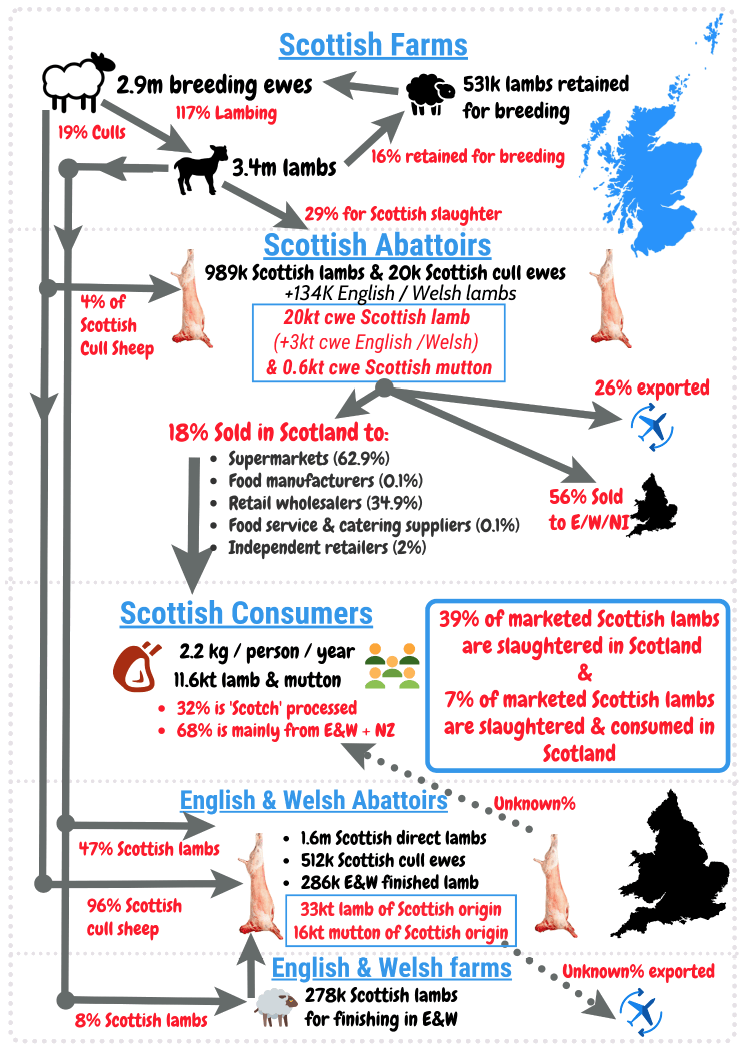
2.3.2 The economics of sheep processing
2.16 Globally, red meat (and particularly sheep) processing notoriously returns low operating margins[16]. The labour requirement per kilogramme of carcase is high in comparison to pigs and beef because sheep are small animals with a low killing out percentage (KO%).[17] For example:
- Pigs in the UK have a KO% of 72-80% (AHDB 2017).
- A typical Scottish steer weighing 700kg has an average 55 KO% yielding a 385kg carcase.
- At an average 44% KO%, a 46kg live lamb is needed to yield the average 20.3kg carcase in Scotland. However, the actual meat yield (i.e. less fat and bone) is generally around 53% of the carcase[18] meaning just 10.8kg of edible meat per average Scottish lamb, and only around 7kg for a typical light finished hill lamb.
2.17 Lamb's low meat yield compared to beef and poultry (largely chicken) meat is shown in Table 1. The table highlights a range of other important parameters influencing the competitiveness of lamb and, along with lamb's high retail price, explains why relative consumption has changed since the early 1970's.
Table 1 How lamb compares to beef and poultry meat
| Poultry | Beef | Sheep | |
|---|---|---|---|
| Annual per capita consumption – | |||
| Scotland (2016) | 28.0kg | 20.8kg | 2.1kg |
| [UK] (2016) | [31.6kg] | [16.8kg] | [4.9kg] |
| {UK} (1973) | {11.7kg} | {19.3kg} | {8.3kg} |
| Meat yield | 35% (19% breast) | 41% | 24% |
| Eating quality | Bland but consistent | Fantastic to awful | Consistently good but "strengthens" through season |
| Production cycle | 36 days | 365-730 days | 50-365 days |
| Feed Conversion Ratio (grain) | 1kg live weight per1.25kg grain | 1kg live weight per 6kg grain | Similar to beef |
| Use of better genetics | Exceptional | Limited | Limited |
| Cost of production | Low | High | Moderate |
| Sensitivity to grain price | High | Very high | Limited |
| Supply chain efficiency | Highly co-ordinated | Disjointed | Disjointed |
| Carbon footprint (AgRECalc) | 3 kg CO2e / kg | 40 kg CO2e / kg | 32 CO2e kg / kg |
Source: Various
2.18 Lamb production is highly seasonal[19] meaning most Scottish lambs are born between March and May. This creates two distinct problems for processors and producers:
a) First, an oversupply of lambs available for slaughter from late June through to late November. Physical capacity to process this throughput is expensive given that for the rest of the year it is underutilised.
b) Secondly, as a consequence of uneven lamb supply, farmgate price volatility is the other major problem. Given that UK supermarkets prefer to keep the retail price steady with periodic price promotions, the processors' margin can be severely squeezed. Figure 7 shows the relationship between the farm and retail lamb price for a "supermarket spec"[20] lamb since 2007 – where the seasonality of the farmgate price is clear (spring peaks and autumn troughs).
Figure 7 UK lamb average farm-retail price spread
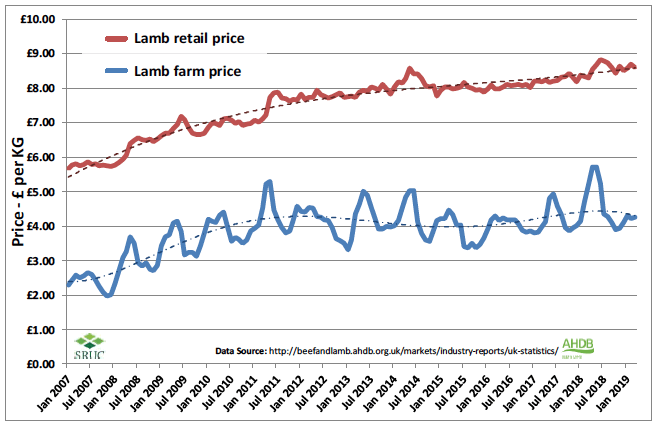
2.19 Traditionally processors made money from "the 5th quarter"[21]. However, following the UK BSE outbreak in the mid 1990's, imposed health regulations meant most of the leftovers from the lamb carcase suddenly became a waste removal cost to processors. Even the value of lamb pelts, which in the recent past ranged between £7-9 per skin, have become largely valueless in the past few years. Turkey and China were key markets for pelts but demand has been hit recently by a combination of changing clothing and footwear fashions and tighter environmental regulations in China.
2.3.3 Competition from processors south of border
2.20 The low margin per lamb processed has driven the rationalisation of sheep processing into a small number of very large plants to exploit economies of scale. Of the three biggest processors in Great Britain (Dunbia, ABP and Kepak), only Kepak slaughter lamb in Scotland.
2.21 The concentration of the large abattoirs and cutting plants in England and Wales has historical reasons that remain relevant today. These primarily are:
a) Proximity to a large customer base, reflecting: England's large population; its greater ethnic diversity, and; the higher incomes in the south-east.
b) Proximity to the EU export market, especially the main ports for transporting product to the continent.
c) A larger production base to draw lambs and sheep from throughout the year. The largest processing plants are: close enough to get lambs from south-west England in the spring; have access to the large main season production base in supply from Wales and England, plus also pull down "surplus" lambs from Scotland from mid-summer through the autumn. Finding sufficient "supermarket spec" on the shoulders of the season, particularly the spring, puts Scottish processors at a disadvantage to plants south of the border.
2.22 In addition to these supply and demand factors the availability of generous capital grant support for facilities may also have been a factor. Both the large plants at Dunbia, Llanybydder and St Merryn, Merthyr have benefitted from EU structural funding. The Merthyr plant was built in 1999 with a grant of over £6.5m and received a further £1.2m in 2010 and it is estimated that this plant operates well below its capacity of 2,400 cattle and 24,000 lambs per week "despite drawing livestock from most of Wales and large parts of England and even Scotland" (Kennard and Young, 2018).
2.23 Whilst these processors are large and dominate the GB sheepmeat market, it should be stressed that the seasonality of lamb production means that some overcapacity is a necessity to deal with peak periods. Therefore, these big processors typically depend on the (EU) export market during such periods. However it is an opportunistic market driven by exchange rates and, in future, a new trade arrangement.
2.3.4 Scottish processor focus on beef
2.24 The Scottish red meat industry focuses on beef, which is unsurprising given Scotland's international reputation for its beef. Scotch Beef enjoys a reputation that translates into a price premium that processors, producers and retailers benefit from. Welsh Lamb enjoys a similar premium reputation, whereas the name Scotch Lamb has limited impact beyond its home (Scottish) market.
2.25 Besides reputation, processors prefer beef for a number of other advantages. Specifically, better carcase balance and yield, more manufacturing options, and a lower (per kg) and more stable procurement cost for animals.
2.3.5 Labour availability
2.26 Processors highlight that finding staff to slaughter and process animals is challenging with staff turnover rates high. It is generally unattractive, repetitive hard work. For a decade and more, "non-UK labour is of fundamental importance to the red meat supply chain is in the slaughter and processing sector…not only is non-UK labour important on the factory floor but it is also key in respect of veterinary inspection" (QMS, 2017a). Most of the non-UK staff in abattoirs and cutting plants are of EU origin, meaning the UKs pathway to leaving the EU (Brexit) is disruptive on existing, and potential future staff. The Scottish Association of Meat Wholesalers estimated that 43% of meat processing sector workers come from the EU in 2017 with recruitment of local staff a sometime challenging due to perceptions of the nature of the work.[22]. Food Standards Scotland estimate that 98% of their official veterinarians are of non-UK origin, mostly the EU (QMS, 2017b).
2.27 In autumn 2018, it was reported[23] that staff shortages were leading to lamb processing challenges as processors prioritised throughput of cattle over lambs. Staffing problems, however, are common to meat processing globally. New Zealand and Australia also struggle with staffing issues. Automation of processes is now a priority in the processing industry to lift labour productivity (reduce staff numbers).
2.3.6 Regulatory burden for smaller abattoirs
2.28 The burden of regulation is cited as a major reason for the decline in smaller processors (Kennard & Young, 2019). The cost of compliance is proportionally larger for smaller firms with responsibility generally added to the small management force. By comparison, large processors have more scope to have dedicated compliance officers.
2.4 The response of Scottish processors
2.29 Faced with the adverse factors explained above, the Scottish sheep processing sector has evolved to achieve a competitive and stable position. In short, Scottish processors largely avoid the opportunistic trades in the commodity export market, instead focusing on domestic supermarkets and the niche, repeatable, premium export trade. The main Scottish processors completely avoid the cull sheep (mutton) market.
2.4.1 Limiting overcapacity is an important goal
2.30 Analysis suggests that a key goal of Scottish lamb processors is to achieve a consistently high utilisation of processing capacity, thereby maximising the return on investment in plant, yards, machinery and labour. Unfortunately, this goal limits the number of Scottish lambs required. Figure 8 shows the relative uniformity of Scottish monthly lamb throughput in recent years, with the exception of the spring through early summer period – this simply reflecting the lack of early lambing sheep flocks in Scotland. The stability of the autumn throughput in Scotland implies that in the autumn months is when Scottish lamb supply naturally peaks, lambs surplus to the more measured needs of Scottish processors are purchased by English and Welsh processors for export to the EU.
2.31 For the significant number of Scottish lambs sold via livestock markets, if export demand is flat, this is reflected in lamb prices. For example, in autumn 2018, when export demand was low, farmers in Ayrshire that sold both deadweight and through the live ring, judged they were £4 per lamb worse off selling through the ring -the highest difference in many years. The worrying implication of a no-deal Brexit is that restricted access to the EU sheep market due to EU tariffs would hit Scottish sheep prices more than in England and Wales, where the big processors requirements are satisfied locally.
Figure 8 Monthly kill of lambs in Scotland compared to England & Wales
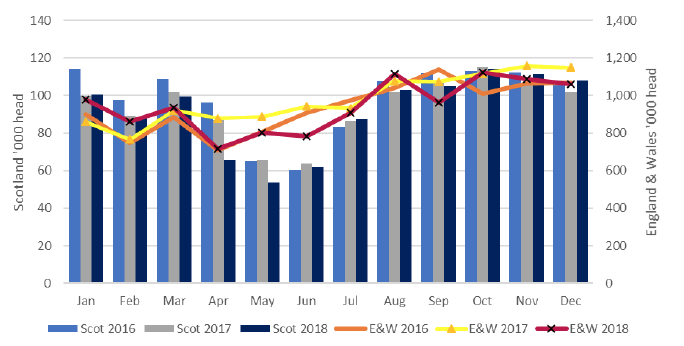
2.32 The price implications for (smaller) light Scottish hill lambs are most significantly affected by Scottish processors' strategic focus on "supermarket specification" lambs. Essentially, the vast majority of these lighter lambs must be sold in England and Wales for slaughter. For example;
- In 2018 about 4,000 sheep (mostly lambs) were slaughtered locally in Shetland. However around 83,000 were lambs (mostly store lambs) and 7,000 sheep were sold off the islands. Most of the Shetland store lambs are finished on farms in Aberdeenshire or the north of England with Dunbia, Preston being the main processor dealing with these sheep with Vivers buying some occasionally.
2.33 That processing overcapacity is less of a problem in Scotland stands in contrast to the likely situation in England and Wales, but also further afield. For example, a common conclusion from a number of major reports commissioned to address the red meat (lamb) processing problem in New Zealand was "the inefficient use of meat plants resulting in poor utilisation and unnecessary cost" (MIE, 2015[24]). However, the MIE (2015) recommendations were never implemented, with outside (Chinese) investment, that provided better integration into the complex Chinese market, the key strategic option used by the New Zealanders.
2.4.2 Good relations with UK supermarkets
2.34 Drawing on industry and expert interviewees a picture of close abattoir and supermarket relations has been identified across Scottish sheep processors. It is noticeable that supermarkets generally market lamb under their own name. Some of the key relationships are:
- Scotbeef processes lambs for both Marks & Spencer (M&S) and Aldi. The relationship with M&S is well developed and was renewed in 2018. Not all of the lamb is sourced from Scotland, with Scotbeef getting lambs killed on contract in Wales. Indeed meeting the M&S specification in terms of fatness, conformation, size and provenance is more important than country of origin. It is notable that M&S aim to take all parts of the carcase and Scotbeef have developed added value products at its Queenslie, Glasgow plant.
- Kepak acquired 2 Sisters and with it Tesco's lamb contract. Kepak's Scottish plant supplies Scotch Lamb to Tesco's Scottish stores plus around half of Tesco GB's organic lamb needs. In addition, the Portlethen plant supplies CostCo's lamb.
- Woodheads is unique as it's a wholly owned subsidiary of Morrisons' supermarket. The Turiff plant slaughters around 9,000 lambs per week (of which just under 1,000 are for a third party). However, Morrisons Scottish stores retail only 1,000 to 1,500 lambs weekly depending on season (17 to 25 lambs per week per store). The Turriff plant also bones and processes most of the lambs killed at its Colne plant in Lancashire.
2.4.3 High value export markets
2.35 Exports of Scotch Lamb beyond the UK totalled around 6,200 tonnes in 2018. Until recently just one company accounted for almost all exports – Scotbeef – though product comes from both the Bridge of Allan plant and sister business Vivers' Annan site.
- Vivers is a specialist exporter with 57% of its turnover coming from EU exports in 2017/2018[25]. Vivers' focus is on selling carcases to premium niche markets in Belgium, France and Italy served via ferry from Dover. This premium market is long established and is based on longstanding personal relationships. However, the lambs sourced for export are not uniquely Scottish meaning it is the reputation of Vivers, rather than the Scotch Lamb brand, that sustains this trade. In addition, Vivers does export some light lamb carcases to Spain, usually for the Christmas festival. Again, the focus is on whole carcases rather than further processed cuts.
- By comparison, exports from Scotbeef's Bridge of Allan plant are normally a by-product of its GB trade (carcase balancing). For instance, when large number of lamb legs are required for customers, surplus shoulders and loins may go for export.
2.4.4 Regulatory burden less of an issue for main processors
2.36 Generally, there were limited concerns regarding the regulatory burden from the key Scottish sheep processors. However, they all noted that compliance with regulations does come at a cost.
2.37 A notable positive comment was how Scottish devolution had improved the relationship between processors and regulators. Food Standards Scotland was well regarded and processor – regulator relations are now improved.
2.4.5 Reasonable margins
2.38 The natural presumption is that processing sheep is a very low margin business hence unattractive. As explained in section 2.3.2 the size and low meat yield of lamb, plus the seasonality of production, poses commercial difficulties for a processor. Pressure from supermarkets to compete on (shelf) price creates a challenge for processors given farmgate price volatility. There is, however, evidence to suggest that Scottish processors deal with this tough trading environment quite well. It seems, there is a reasonable margin in processing lambs given a well implemented business strategy.
2.39 To fully process a lamb carcase into packaged shelf ready cuts costs around £15 per lamb, so if adding in a profit of (say) £2, around £17 per lamb goes to the processor for a supermarket specification (16-20kg cwe) lamb.
2.40 Whilst typical red meat processing profit margins are about 1-2% profit margin[26],[27] published accounts of specialist sheep producers suggest profit margins of 4-5% can be achieved. With lamb procurement costs typically accounting for 85%-90% of turnover other operating costs are minimised by: (i) working with established customers rather than searching opportunistic trades, and (ii) dealing primarily in carcases or main carcase parts (shoulder, loin and rear legs) to reduce the need for expensive butchering and enable streamlining of operating processes.
2.41 Woodheads is part of Morrisons so its "profit margin" is internalised. The benefits of the Morrisons' vertically integrated model, focusing on the supermarkets pig supply chain was reported by Bowman et al (2012). The opportunities provided by better supply chain integration are discussed in chapter 4.
2.42 How processors profitably adjust their kill capacity is critical to the economics of processing. It is understood that Kepak plans to double their throughput this year by putting on a second shift team. As such, the marginal (additional) costs of processing more lambs are: the procurement cost of lambs; labour cost; associated packaging materials, plus; greater wear and tear of equipment. The cost of skilled labour is particularly important. A recent example of the importance of using processing capacity efficiently comes from New Zealand. The profitability of New Zealand processor Silver Fern Farms was hit in 2018 by farmers retaining lambs to grow to heavier carcase weights thanks to good early summer rains.[28] However, the processing plants were manned-up to take the normal December throughputs. Farmers opted to get more value on their lambs at a cost to the dividend they receive through the ownership of their processor.
Contact
Email: socialresearch@gov.scot
There is a problem
Thanks for your feedback